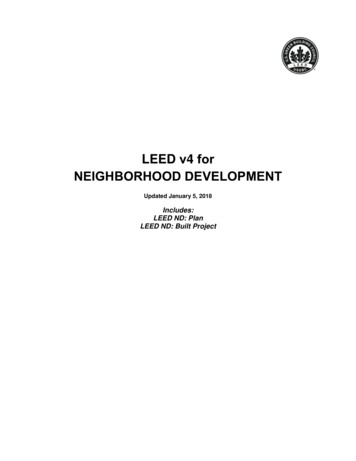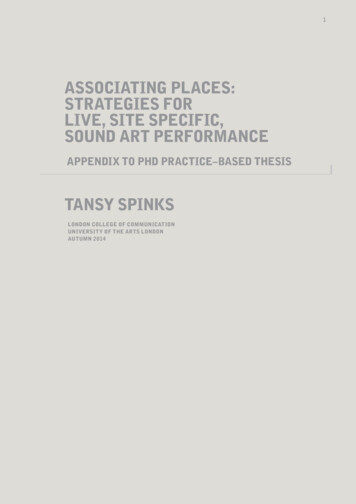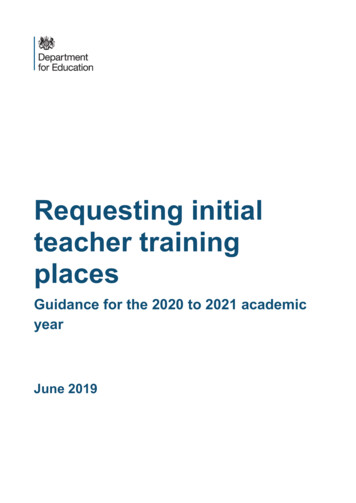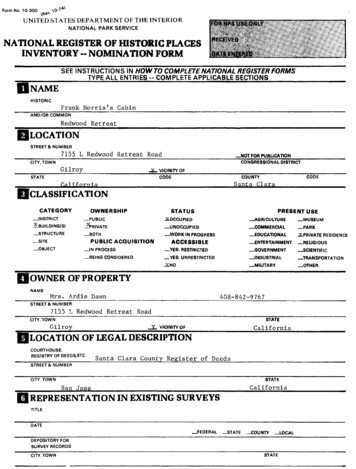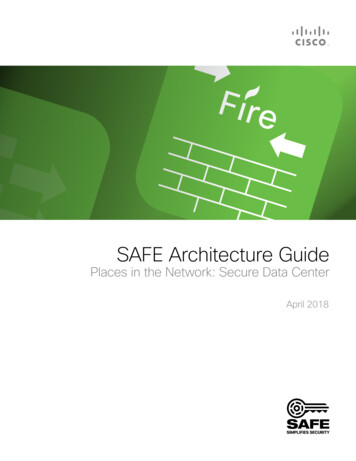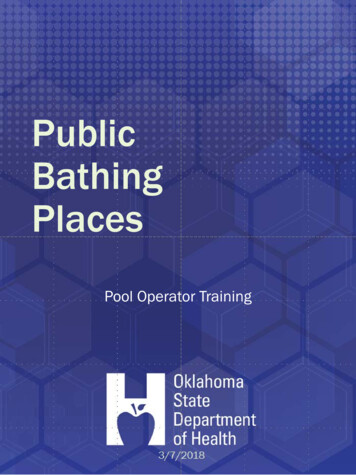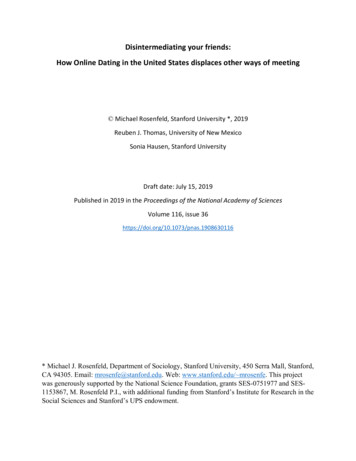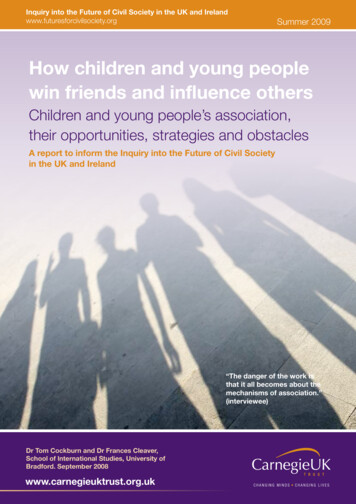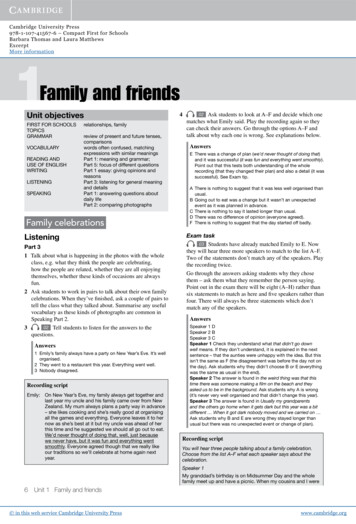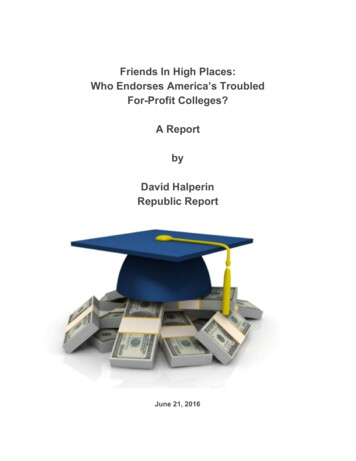
Transcription
Friends In High Places:Who Endorses America’s TroubledFor Profit Colleges?A ReportbyDavid HalperinRepublic ReportJune 21, 2016
SummaryTimothy J. Hatch and Ronald L. Olson are two of the most prominent and successfullawyers in Los Angeles. Hatch is a partner at the national litigation powerhouse firm GibsonDunn. Olson, a name partner at Munger, Tolles & Olson, has represented some of America’sbiggest corporations. He is a former chair of the American Bar Association’s Litigation Section,and today he serves on the boards of directors of Warren Buffett’s Berkshire Hathaway, theRAND Corporation, the Mayo Clinic, and the California Institute of Technology.Both Hatch and Olson also have been for years key parts of the protective infrastructurethat has shielded predatory for profit colleges, institutions that have deceived and abused U.S.students and taxpayers. Hatch has represented the giant publicly traded for profit collegebusinesses Education Management Corporation (EDMC), Kaplan, ITT Tech, Bridgepoint, andApollo / University of Phoenix, against charges of fraud, and he has sued the U.S. Departmentof Education to halt regulations that would hold poorly performing colleges accountable. Olsonis on the board of directors of Graham Holdings Company, which owns Kaplan, and his law firmhas represented Corinthian in major fraud litigation which is fitting, as the Graham companyowned a significant stake in Corinthian until its 2015 collapse. In the f raud case where Olson’sfirm represented Corinthian, the other party that whistleblowers were suing was Corinthian’sauditor, giant accounting firm Ernst & Young. Their lawyer in the case was Timothy Hatch .Although the notorious Corinthian Colleges is gone ( sort of ), many bad actors remain inbusiness. Seven of America’s ten biggest for profit college companies, which collectivelyreceived about 8 billion dollars in taxpayer money last year, have in recent months and yearsbeen under investigation or sued by federal and state law enforcement agencies for deceptivebusiness practices. Despite the mounting evidence that these seven companies Apollo/University of Phoenix, EDMC, ITT Tech, Kaplan, Career Education Corporation, DeVry, and1
Bridgepoint Education have engaged in predatory behavior against their own students, theycontinue to market themselves as affordable places to build successful careers, and theycontinue to enroll new students and deposit their federal grants and loan checks. Thesecompanies also have continued to fight reform measures by government to hold bad schoolsaccountable for abuses.A key reason why such predatory for profit colleges have been able to continue receivingbillions annually in taxpayer dollars while ruining the financial futures of students across thecountry is that national power players politicians, lawyers, academic leaders, celebrities have been willing to vouch for these companies, serving as their paid lobbyists, board members,investors, and endorsers. It’s not just Donald Trump who has made big money off a deceptivecollege operation.Although some well known Americans have severed their ties to the industry in recentyears, the many prominent people who have continued to lend their credibility to one or more ofthese seven troubled for profit college companies include: Columbia University president LeeBollinger, University of Arizona president Ann Weaver Hart, Senator John McCain, publisherSteve Forbes, Democratic former U.S. Deputy Attorney General Jamie Gorelick, former Houseof Representatives GOP leaders Vin Weber and Deborah Pryce, senior Republican adviserCharlie Black, and talk show host Ellen DeGeneres.These pillars of American society uphold a shining edifice protecting corporations thathave been in the sustained practice of ripping off students and taxpayers on an enormous scale.The skills and reputations that they lease to predatory for profit colleges help to deflect attacksand allow abuses to go on, year after year.In our system, everyone accused is entitled to a lawyer, and companies are entitled topetition the government, advertise, and otherwise make themselves heard. But, in turn, the2
public is entitled to evaluate the records of individuals who choose to be lobbyists, investors,board members, or validators for a predatory company, consider whether their work is harmingthe public interest, and further consider whether such persons, despite all theiraccomplishments and good deeds, should continue to command our respect, and be eligible forpositions of trust in more responsible corporations and institutions, and in government. That is adiscussion I hope to advance with this report.The For Profit College ControversyIn recent years, America’s for profit colleges schools organized as businesses ratherthan non profits or state institutions have received as much as 32 billion a year in federalstudent aid. Although some for profit programs do a good job training students for careers, andthere are good teachers at even some of the worst behaving schools, g overnment and mediainvestigations have revealed that many for profit colleges have deceived and coercedprospective students, misled regulators, charged sky high prices, and left numerous dropoutsand graduates alike buried in debt and without improved job outlooks. As an advocate forstudents, I have spoken with , and written about , scores of Americans who wanted to train forcareers as medical assistants, computer technicians, diesel mechanics, or other jobs and endedup ripped off, unemployed, and deep in debt. I’ve also spoken with many employees andexecutives in this industry who have recounted brazen, cynical efforts to defraud students andgovernment overseers.More than half of the students who have enrolled in for profit colleges many of themveterans, single mothers and other low and middle income people seeking a better future dropped out within about four months . The relentless drive to meet recruiting and revenue goals to get “ asses in classes ” has led many for profit schools to e nroll numerous students whomtheir programs are not strong enough to a dequately assist . Many of these colleges have beencaught using deceptive advertising and misleading prospective students about matters like3
program costs, accreditation, transferability of credits, job placement rates, and likely startingsalaries. Although for profit colleges often promise that their programs are affordable, the realcost can be nearly double that of Harvard or Stanford. But the quality and reputation of theprograms are often weak, so even students who manage to graduate often struggle to find jobsbeyond the Office Depot shifts they previously held.The U.S. Department of Education has r eported that 72 percent of the for profit collegeprograms it analyzed produced graduates who, on average, earned less than did high schooldropouts. A May 2016 study published by the National Bureau of Economic Researchconcluded that for profit college students, graduates and dropouts combined, earned less afterleaving school than they did before they enrolled.Today, 10 percent of all college students attend for profit colleges, on campuses andonline but these institutions account for 4 0 percent of student loan defaults. For profit schoolsare driving a national student debt crisis that has reached 1.3 trillion in borrowing. They absorb20 percent of all federal student aid, diverting sums from better, more affordable programs atnonprofit and public colleges.Just a few years ago, this badly behaving industry was flying high, with large Wall Streetinstitutions like Goldman Sachs and W ells Fargo taking major shares in large publicly tradedhigher education companies, and private equity firms dominating some others. Industryrevenues had soared, as students, lured by powerful sales pitches, had flocked to enroll. Theindustry’s main trade group, the Association of Private Sector Colleges and Universities(APSCU), was holding lavish conventions, and industry executives enjoyed f ancy homes ,private planes , nights on the town , Park Avenue dinner parties , and fancy ski junkets .The industry thrived, also, by always remembering that it was fueled almost entirely byfederal aid dollars some schools were getting 90 percent or more of their money from the U.S.4
Departments of Education, Defense, and Veterans Affairs. Recognizing that federal policy wasthe key to making more and more revenue, the for profit college industry set aside some of itsearnings to build a powerful Washington D.C. presence , and it lobbied successfully for changesthat opened the federal spigots even wider at the expense of accountability and studentoutcomes.Faced with the reality in 2009 that the new Obama Administration was prepared to startcracking down on industry abuses, the for profit colleges could have pursued a deal that wouldmandate certain reforms but perhaps allow bad actors to keep some of their predatory businessmodel intact. Instead, the industry decided to wage war hiring the most expensive andconnected Washington lobbyists and lawyers; ramping up campaign contributions; makingphony attacks on advocates for reform ; and buying the endorsement or partnership ofcelebrities, think tanks, even media outlets to try to improve its public image.As described in news reports , pressure from the for profit college industry, and fromMembers of Congress in both parties who have accepted campaign contributions from theindustry, helped weaken the Obama Administration’s leading initiative to reform the sector: the“gainful employment” rule, which imposes penalties, and possible loss of federal aid eligibility,for career education programs that consistently leave former students with insurmountable debt.The for profit college industry, in fact, has fought the Administration aggressively on everyrelevant issue.But while the gainful employment rule lost some of its force as compared with its initialincarnation, the rule has survived , and several other Obama administration i nitiatives have goneforward to increase accountability on the sector. Meanwhile, with the industry choosing anall out fight, scrutiny of for profit colleges in the U.S. Senate, especially when Democratscontrolled the chamber; in the media; and by state and federal law enforcement agencies hasincreased. And advocacy on behalf of abused for profit college students, which in 2009 was5
mostly limited to a small group of organizations, has expanded to an increasingly cohesive anddetermined coalition of more than 50 student, veterans, civil rights, consumer, educator, andeducation policy groups. (Disclosure: Going back to my time at Campus Progress / Center forAmerican Progress and continuing after I became a self employed lawyer in 2012, I haveworked to build and increase the influence of this coalition.)All of this effort, spurred in large part by industry intransigence, has helped produce adramatic reversal of fortune for for profit colleges. In recent years, exposure of abuses havehelped send enrollments and share prices plummeting, regulators have pressed for greateraccountability measures, and many companies are closing campuses as they face mountingfederal and state law enforcement probes , as well as financial and administrative instability .Some major for profit colleges have now collapsed or are in peril. Billions of dollars infor profit college student loans are already in default, and former students across the countryare now demanding that the Department of Education, having v ouched for fraudulent schools,forgive their debts. Many of the big for profit colleges, which had egged on the trade groupAPSCU to engage in all out war in Washington against the Obama Administration, have nowquit that group , leaving the organization s hort of funds and with a d epleted staff . APSCU wasso desperate to start over that in June 2016 it changed its name to Career Education Collegesand Universities, its second name change in six years.But today, some 20 billion annually in taxpayer money continues to flow to for profitcolleges, and for some of the biggest, baddest actors in the industry, the business model hasstayed fundamentally the same: deceptive online, TV, and radio marketing; coercive recruiting;enrollment of students in programs that cannot help them succeed; mixed quality instruction;and high prices. As you read this, for profit colleges are using bait and switch tactics, andmisleading, high pressure sales pitches, to convince your fellow citizens single parents,6
returning veterans, and others seeking a better future to enroll in education programs that willruin their financial futures, and further burden U.S. taxpayers.Just as disturbing, the Washington D.C. business model has not changed much either.At least some in the industry remain in a take no prisoners mode, continuing to spend millionsannually buying influence in Washington. Industry players, including APSCU, continue to try tooverturn the gainful employment rule in the courts and in Congress. Powerful members ofCongress like Rep. John Kline (R MN), Rep. Virginia Foxx (R NC), and Rep. Alcee Hastings(D FL), once agressive public champions of this industry, seem less interested in defendingfor profit colleges in public forums, but they remain reliable votes to overturn ObamaAdministration reforms to hold the industry accountable, just as they have continued to receivecampaign contributions from industry executives.1 For profit colleges continue to hire revolvingdoor lawyers and lobbyists to pressure the Administration against imposing penalties forabuses. They fight tenaciously in court against industry whistleblowers and students seekingrelief for abuses paying high priced corporate litigators out of revenues that often are 90percent taxpayer dollars.The industry continues to have traction because it retains enough cash to hire some ofthe most expensive and esteemed validators and defenders that money can buy.Endorsers of for profit colleges in the past decadeThe lure of for profit college money is so strong that both of the leading candidates forpresident in 2016 are linked to the industry. D onald Trump ran his own for profit TrumpUniversity, which was unaccredited and thus not eligible for federal student aid; Trump’s1Fortunately, strong congressional champions for students have pressed the Administration hard for tougherreforms and have stood up to efforts to gut reforms through legislation. These champions have includedSenators Dick Durbin (D IL), Elizabeth Warren (D MA), Sherrod Brown (D OH), Richard Blumenthal (D CT),and Patty Murray (D WA), and Representatives Maxine Waters (D CA), Elijah Cummings (D MD), KeithEllison (D MIN), and Mark Takano (D CA).7
“ school ” is now the subject of fraud lawsuits by New York’s attorney general and by formerstudents who feel cheated and want their money back. Meanwhile, in 2009, as Secretary ofState, Hillary Clinton pressed to include in a State Department event on education policy thegiant for profit college company Laureate Education, which several months later hired BillClinton to be “honorary chancellor” of its international division and paid him 16.5 millionbetween 2010 and 2014. (However, while Trump continues to d efend the conduct of hispredatory “university,” Hillary Clinton, to her credit, has c riticized for profit college abuses andpledged to crack down on bad actors.)But Clinton and Trump are far from the only ones. Here are just a few more examples ofother powerful Americans linked in recent years to for profit colleges: 2012 GOP presidential nominee M itt Romney (R MA), as a candidate in that race,extolled the virtues of for profit colleges, including the University of Phoenix and Florida’sFull Sail University. Romney didn’t disclose that the private equity owners of Full Sail andVatterott College , both schools with troubling records, were m ajor donors to hiscampaign or that Romney’s own private equity firm, Solamere Capital, w as invested inthose schools. Former 2016 presidential candidate Senator M arco Rubio (R FL) in 2014 w rote to theU.S. Department of Education asking it to “demonstrate leniency” to for profit giantCorinthian Colleges, despite the strong evidence that the company was deceivingstudents and government regulators alike. Corinthian was a donor to Rubio’s politicalaction committee. Corinthian, one of the worst actors in the entire sector, has sincecollapsed under the weight of disturbing revelations and multiple law enforcementinvestigations.8
Richard Gephardt (D MO), the former House Majority Leader, was paid 360,000 in2010 11 the height of the first gainful employment rule fight to lobby for Corinthian.2 Former Obama Secretary of Defense L eon Panetta and National Urban Leaguepresident Marc Morial both joined Corinthian’s board of directors in June 2013 longafter it was clear that the company had engaged in troubling behavior. Facing publiccriticism, Panetta soon quit, but Morial stayed on , collecting 60,000 annually in directorfees, plus stock options, until the company shut down. Former Senate Majority Leader T rent Lott (R MS), former Senator John Breaux(D LA), and their firm, Squire Patton Boggs, received 1.44 million over four years,ending in late 2015, to lobby for the for profit college trade group A PSCU , which hasincluded in recent years many of the industry’s most troubled companies, such asCorinthian, Education Management Corp. (EDMC), ITT Tech, Kaplan, Career EducationCorporation (CEC), DeVry, and Bridgepoint Education. APSCU also included A TI , whichwas shut down by the Justice Department in 2013 for systematic fraud, and F astTrainCollege , whose CEO was s entenced to eight years in prison in May 2016 for defraudingthe government. Former Secretary of State Colin Powell has for a number of years been the chair of theadvisory board of Leeds Equity Partners, which invests in for profit education and untilrecently owned a major stake in the second largest for profit college company, EDMC.EDMC recently agreed to pay or forgive some 200 million to settle multiple fraud suitsbrought by federal and state law enforcement. The private equity firm’s founder, JeffreyLeeds , has been an aggressive advocate against accountability for the sector, and heserves on the board of APSCU; Powell praised the industry when he was the keynotespeaker at the APSCU convention in 2011. B ill Clinton (2009), George W. Bush(2012), and Jeb Bush (2014) also were keynote speakers at APSCU conventions, and2Information on lobbying representation and fees comes from disclosure forms that lobbyists are required bylaw to file with Congress and are posted on this site .9
in his APSCU speech Jeb Bush sharply attacked the Obama gainful employment rulethat the for profit college industry so despises. Another EDMC insider was former Maine governor J ohn McKernan (R), who was CEOand then executive chairman of the company from 2003 to 2008 and then served aschairman of the board in the period when the company r atcheted up its predatorypractices . Another private equity owner of for profit colleges is former New Jerseygovernor Tom Kean (R), whose company, Quad Partners, has invested in collegesincluding Marinello School of Beauty , which was shut down for fraud by the Departmentof Education in February 2016. And former Pennsylvania governor E d Rendell (D)joined with Kean in a for profit college industry funded group called the F oundation forEducational Success , which was supposed to create a voluntary code of conduct for theindustry as an alternative to government regulation. The foundation and code of conductwere trumpeted in a press release and in a P olitico op ed by Kean and Rendell neitherof which disclosed that the foundation was funded by for profit colleges or that Kean isan owner of for profit colleges. The code of
students and taxpayers. Hatch has represented the giant publicly traded for profit college businesses Education Management Corporation (EDMC), Kaplan, ITT Tech, Bridgepoint, and Apollo / University of Phoenix, agai
